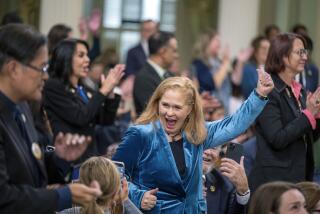CAPITOL JOURNAL : Assembly Takes Charge of Its Image With Live Broadcasts of Sessions
- Share via
SACRAMENTO — Fed up with the media’s coverage of lawmakers, Assembly Speaker Willie Brown (D-San Francisco) appears to be gambling that live, moving pictures will be worth more to his institution’s image than the thousands of words written every month about the Legislature’s lower house.
After six months of tests and dress rehearsals, Monday marked the debut of an Assembly project to televise its proceedings live on cable television to Californians.
Pictures from five remote-controlled cameras mounted in the Assembly chamber were sent via satellite to 22 cable television systems, making the action available to 1.5 million households from San Diego to Eureka--although only portions of Van Nuys and Lakewood in Los Angeles County can now receive the program. Promoters of the project, which has cost the state more than $1 million so far, hope it will reach every cable viewer in the state.
Cal-SPAN’s five-hour inaugural telecast--which included some canned coverage and a live committee hearing--was not without a hitch. The debut coincided with the first Assembly session since the resignation of several top staff members who took advantage of a generous severance package offered as a way to trim the payroll in compliance with Proposition 140.
With the chief clerk and several of his aides gone, the Assembly tripped and stumbled through its short agenda. Votes were cast and recast as the new clerks struggled to post the correct items on the chamber’s electronic tally board.
The mistakes made the proceedings seem amateurish. The confusion prompted some members to revert to the kind of catcalls and insults that helped tarnish the Assembly’s image in the first place.
“It was unfortunate,” Assemblyman Mike Roos, the Los Angeles Democrat who presided over the day’s events.
Under the agreement with the nonprofit group that operates Cal-SPAN, the Assembly controls what is seen by the cameras. Cal-SPAN distributes the signal to the cable systems but is not allowed to edit what viewers see. Its only option is to decline to broadcast the sessions.
The fledgling effort to televise the Assembly dovetails with Speaker Brown’s recent decision to banish newspaper reporters and commercial television cameras from the Assembly floor. They are now crowded into the rear of the chamber and must pass notes to the sergeant-at-arms before making contact with members.
Brown delivered that edict last month through the Rules Committee, whose members he appoints. He enforced it in dramatic fashion last Thursday when he ordered the removal of three television reporters during debate on a resolution involving the Persian Gulf War.
Brown’s action--coming so close to the debut of the television project--has fueled suspicion among journalists that he is trying to spoon-feed his version of the news to the public while making it harder for the commercial media to do its job.
“This is a great effort at image enhancement by an institution that needs work on its image,” said Steve Swatt, a veteran reporter for KCRA in Sacramento who was among those booted off the floor last week.
Brown denies that his effort to improve decorum on the floor is tied to the start of the Assembly television project. He said Monday he believes that the Legislature and public will be better served by his operation than by the judgment of reporters, editors and broadcasters.
“It will give citizens an opportunity to see something other than an edited version of the state Assembly,” Brown said. “People should be allowed to see things in the raw. It’s equal time, for a change.”
Some of Brown’s political opponents believe he has badly misjudged the power of raw television coverage. Many Republicans think voters will be alarmed when they see for themselves what is done in the Assembly, which is dominated by liberal Democrats.
“This is going to be a godsend for our party,” said Assemblyman Gil Ferguson, a conservative Republican from Newport Beach. “This is raw and ugly and the fact that it is allows the minority party to have its voice heard. That’s a dumb mistake by the Speaker because our message is the message that’s supported by the people of California.”
More to Read
Get the L.A. Times Politics newsletter
Deeply reported insights into legislation, politics and policy from Sacramento, Washington and beyond. In your inbox twice per week.
You may occasionally receive promotional content from the Los Angeles Times.










